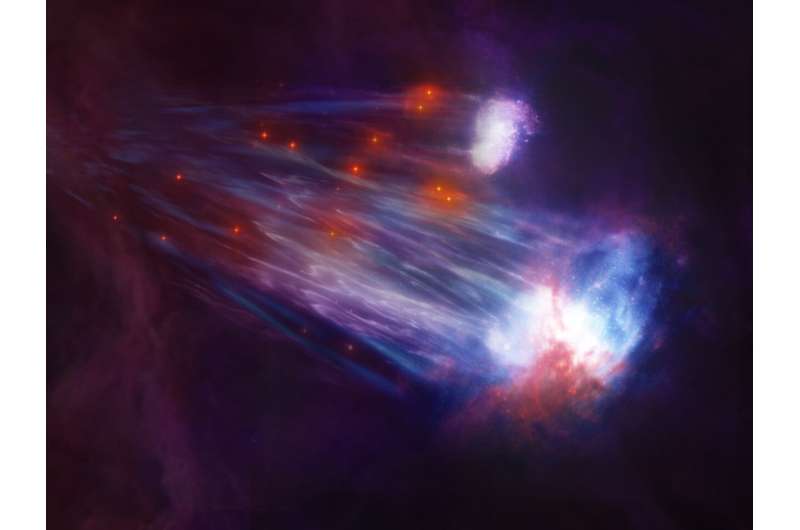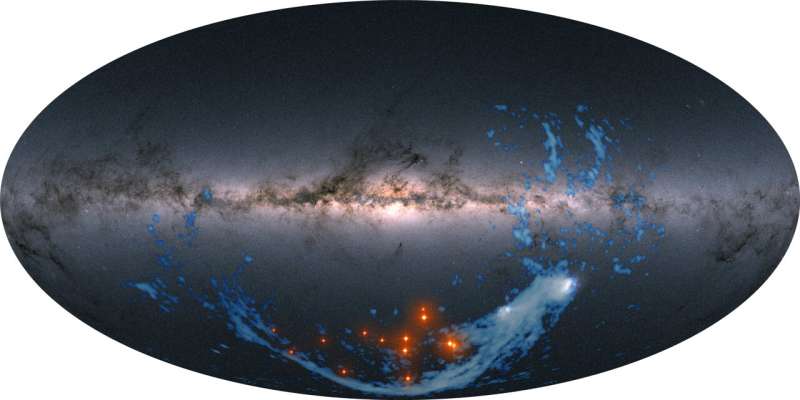This article has been reviewed according to Science X's editorial process and policies. Editors have highlighted the following attributes while ensuring the content's credibility:
fact-checked
peer-reviewed publication
trusted source
proofread
Distant stars spotted for the first time in the vast Magellanic Stream

For nearly fifty years, astronomers have come up empty-handed in their search for stars within the sprawling structure known as the Magellanic Stream. A colossal ribbon of gas, the Magellanic Stream spans nearly 300 moon diameters across the Southern Hemisphere's sky, trailing behind the Magellanic Cloud galaxies, two of our Milky Way galaxy's closest cosmic neighbors.
Now, the star search is finally over. Researchers at the Center for Astrophysics | Harvard & Smithsonian (CfA) and colleagues have identified 13 stars whose distances, motion, and chemical makeup place the stars squarely within the enigmatic stream.
Locating these stars has now pinned down the true distance to the Magellanic Stream, revealing that it extends from 150,000 light-years to more than 400,000 light-years away. The findings pave the way to map and model the Magellanic Stream in unprecedented detail, offering new insights into the history and characteristics of our galaxy and its neighbors.
"The Magellanic Stream dominates the Southern Hemisphere's sky, and our work has at last found a stellar structure that people have sought for decades," says Vedant Chandra, a PhD student in Astronomy & Astrophysics at the CfA and lead author of a new study published in The Astrophysical Journal reporting the findings.
"With these results and more like them, we hope to gain a far greater understanding of the formation of the Magellanic Stream and the Magellanic Clouds, as well as their past and future interactions with our galaxy," said co-author Charlie Conroy, a Professor of Astronomy at the CfA and Chandra's advisor.
The Large and Small Magellanic Clouds are dwarf satellite galaxies of the Milky Way. Visible to the naked eye as gauzy luminances, the Clouds have been known since antiquity. With the advent of increasingly powerful telescopes able to perceive phenomena too faint for our eyes to see, astronomers discovered a gigantic plume of hydrogen gas apparently cast out of the Clouds in the early 1970s.
Studies of the gas within this Magellanic Stream further showed the Stream to have two interwoven filaments, with one originating from each Cloud. These features suggest the gravity of the Milky Way might have pulled the Magellanic Stream out of the Clouds. Yet how exactly the Stream formed has remained challenging to nail down, partly because its presumed stellar component remains irksomely indiscernible.
Chandra came at this problem through an ambitious project started in 2021 for his PhD at the CfA. Chandra consulted with Conroy about interesting topic areas to study, and Conroy pointed Chandra to the uncharted frontier of the Milky Way. The scant stars dotting the galaxy's outskirts have been little studied because our solar system is smack dab in the starry disk of the Milky Way itself—akin to a concertgoer near the stage attempting to see somebody all the way out at the crowd's periphery.

Over the last decade, though, deep observational catalogs compiled by new instruments—especially the European Space Agency's Gaia spacecraft—have started to spy stellar objects that just might be these elusive frontier stars. With access granted to the 6.5m Magellan Baade Telescope at Las Campanas Observatory in Chile through the CfA and MIT, Chandra undertook a project to perform spectroscopy on 200 far-flung Milky Way stars, which, when completed, will be the largest such sample set to date.
Spectroscopy involves collecting enough light from an object to detect specific signatures imprinted within the light's color bands that, like fingerprints, uniquely identify individual chemical elements. These signatures thus disclose the chemical makeup of an object, speaking to its origins. In addition, the signatures shift based on the distance to an object, enabling astronomers to tell where an object, such as a star, is going and, correspondingly where it came from.
In the case of Chandra's study, the spectroscopic analysis revealed a set of 13 stars with distances and velocities that fall right within the range expected for the Magellanic Stream. Moreover, the stars' chemical abundances matched those of the Magellanic Clouds, for instance, by being distinctively deficient in the heavier elements astronomers call metals. "These 13 stars just fell right out of our dataset," says Rohan Naidu, co-author on the study and former CfA graduate student, currently a Hubble postdoctoral fellow at MIT.
By obtaining solid distance and extent measurements of the Magellanic Stream via these stars, the researchers buttressed its origin story as a gravitational grab by the Milky Way. The researchers were additionally able to calculate the Stream's overall gas distribution with higher confidence compared to prior estimates. The distribution indicates that the Stream is actually about twice as massive as generally reckoned.
That result, in turn, presages a future full of new star formation in the Milky Way because the Stream is actively falling into our galaxy, according to previous observations. In this way, the Stream serves as a primary provider of the cold, neutral gas needed for making fresh Milky Way stars.
"The Magellanic Stream is the dominant source of stellar calories for the Milky Way—it's our breakfast, lunch, and dinner," says Ana Bonaca, a co-author on the study and former ITC postdoctoral fellow at the CfA, now a staff scientist at Carnegie Observatories. "Based on the new, higher mass estimates for Magellanic Stream, the Milky Way may end up packing on more pounds than initially thought."
Further studies of the Magellanic Stream should also help astronomers learn more about the composition of our galaxy. Because the Stream is thought to trace the past paths of the Magellanic Clouds, modeling the evolution of the relatively massive Large Magellanic Cloud via the Stream will improve measurements of the Milky Way's mass distribution.
Much of that mass is in the form of dark matter—a poorly understood, gravity-exerting substance. Better gauging the mass of our galaxy out in its distant hinterlands will aid in accounting for ordinary matter versus dark matter contents, constraining the possible properties of the latter.
"The beauty of having a vast stellar stream like the Magellanic Stream is that we can now perform so many astrophysical investigations with it," says Chandra. "As our spectroscopic survey continues and we find more stars, we're excited to see what other surprises the Galactic outskirts have in store for us."
More information: Vedant Chandra et al, Discovery of the Magellanic Stellar Stream Out to 100 kpc, The Astrophysical Journal (2023). DOI: 10.3847/1538-4357/acf7bf
Journal information: Astrophysical Journal
Provided by Harvard-Smithsonian Center for Astrophysics





















